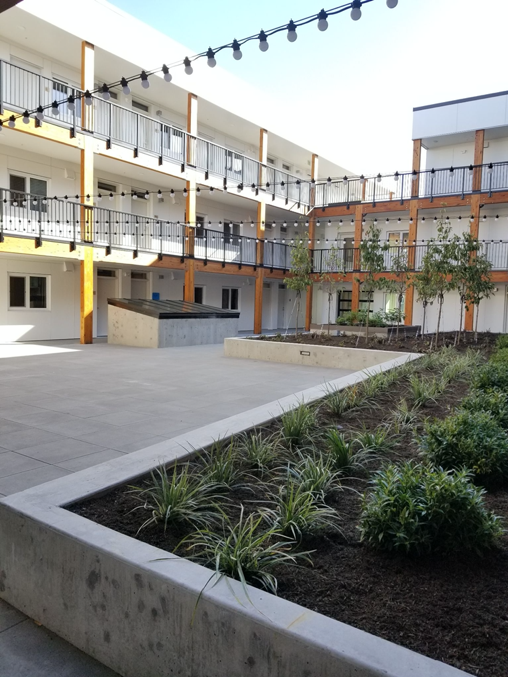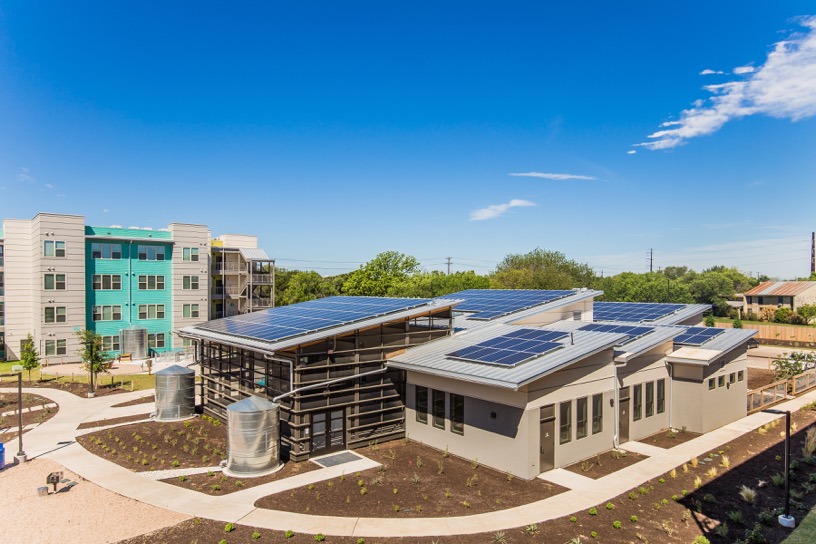Triple Bottom Line Benefits for Residents
Zero Energy homes are not only environmentally sustainable, they also cost less to operate, and are healthier to live in. Low-income families have a far higher cost burden for utilities, spending, on average, 17% of their income on utility bills, compared to 2-3% for other households.[1] Affordable housing units tend to be older and less energy efficient, meaning that low-income households also pay more for utilities on a square foot basis—up to twice as much as median-income households and three times as much as high-income households.[2] Within the Gila River Indian Community in the Sonoran Desert south of Phoenix (the location of the Gila River Indian Community Sustainable Housing), nearly 50% of the community lives below the federal poverty line ($12,490 for an individual per year), while these same residents face utility bills of up to $600 per month in the summer.
In addition to these profound economic impacts, energy inefficient homes also pose health risks to low-income residents. The American Academy of Pediatrics in 2004 issued findings that households receiving Low-Income Home Energy Assistance benefits showed lower rates of malnutrition and lower incidences of acute emergency room visits among children than similar households, suggesting that access to affordable energy is also a public safety benefit.[3] Numerous studies have also confirmed the indoor air quality issues related to gas appliances, which can exacerbate asthma, heart conditions, and other chronic illnesses that are more prevalent in low-income communities. The California Air Resources Board voted last November to support all-electric buildings after research linking health impacts, including an increased vulnerability to symptoms of COVID-19,, to emissions from natural gas appliances
As we continue to deplete our store of fossil fuel resources, energy prices will rise, while prices for renewable energy systems, especially solar photovoltaic (PV) panels and energy storage systems, will continue to decline .[4] The International Renewable Energy Agency (IRENA) reports that the cost of PV electricity in the United States has fallen 72% since 2011. Globally, the price of electricity generated from wind and solar is now on par with fossil fuels.[5] The cost of utility-scale solar in the United States is now an average of 0$0.07/kWh (with onshore wind coming in at around $0.05/kWh), as compared to $0.05 to $0.17/kWh for fossil-fuel-derived power.
Zero Energy Solutions
Affordable housing tenants and owners of affordable housing buildings will find significant relief from the financial instability that comes with rising energy bills through Zero Energy strategies. On-site energy generation through photovoltaic panels paired with storage capacity increases a community’s resilience during times of disaster or price spikes in grid-provided, non-renewable energy. Solar energy and other renewable energy options also provide local jobs through on-site installation and maintenance, while creating the potential for regional manufacturing. Low-income residents deserve freedom from energy bills. In cases where residents do not directly pay utility bills, zero-energy buildings allow for the Affordable Housing Developer to build more units of housing or provide other amenities, rather than spending money on energy bills.
Many of ILFI’s Affordable Housing Pilot Projects are in the process of designing and building Zero Energy housing. Among these projects, a few steps and strategies have emerged as key.
Passive Strategies
The first step is to look at all energy use reduction strategies that are cost neutral. These include architectural design strategies related to building massing, building orientation, and daylighting. Maximizing the potential to use the building itself as a passive conditioning system through solar gains, preconditioning of air or water, convection, evacuation, air separation, and other methods means that the loads on mechanical systems will naturally be lower, requiring less elaborate or expensive systems
Likewise, initial design moves related to building orientation and massing can also play a big role in a project’s ability to maximize the use of daylighting throughout the day and can greatly minimize the use of electric lights.
Common Spaces and Corridors
Common spaces within multifamily buildings account for a large portion of the energy consumption—based on project team reports. Often 20–30% of the energy use of the entire building is associated with these areas. Ventilation and lighting systems within corridors are sometimes over-designed or not thoroughly commissioned. The energy demands of corridors and vertical circulation, such as stairwells, can be reduced drastically for zero or less cost through a detailed evaluation of service levels and conditioning expectations in each space. For example, moving a corridor to the exterior of the conditioned envelope may permit the downsizing or removal of lighting and conditioning loads associated with these spaces. This has the additional benefit of giving units direct access to outside air for cross-ventilation, which is otherwise not possible in an interior layout, particularly in a double-loaded corridor. Exterior corridors also allow residents to feel more connected to the natural world as they circulate throughout the building, because they experience the time of day, weather, and lighting levels that are occurring naturally outside.

Similarly, creating attractive and pleasant stairwells that are open to the air and which provide views helps decrease the energy associated with the elevator, which often runs throughout the day and can be difficult to model accurately prior to construction. Such stairwells also have the added benefit of promoting a healthy and active lifestyle. Ensuring that the stairwell is featured prominently in relation to the front entrance of the building is critical and also does not represent any added cost.
Envelope and Systems
Domestic hot water systems have been shown, through a number of affordable housing pilot projects, to represent a disproportionately high relative percentage of energy consumption in housing, particularly in milder climates. Focusing on reducing energy costs associated with domestic hot water use—by choosing more water-efficient fixtures, shorter distribution runs, and the inclusion of electric heat-pump-based water heating units—should be considered by all project teams.Simple investments in additional continuous insulation and best-practice detailing to yield a tighter envelope can make a long-lasting reduction in the building’s energy demands, as well as an increase in comfort. These investments in the envelope help reduce the amount of heating and cooling energy that is required. While tenant energy use behavior can be variable, affordable housing developers can set residents up for success by providing efficient appliances or equipment. For example, installing and providing LED light bulbs, ENERGY STAR appliances, and high-efficiency rated laundry systems can significantly reduce the plug loads associated with each unit. Some developers have found it prudent to even purchase consumer appliances such as televisions for each unit to ensure older energy-draining appliances are not used, particularly when energy costs are not directly paid by tenants.
Learning from Tradition
The original inhabitants of a place can often provide simple, time-tested, and climate-appropriate solutions. For example, the indigenous tribes in Alaska traditionally used thermal mass, sod roofs, arctic entries (a kind of vestibule that isolates the cold and particulates from entering the rest of the house), and local building materials (which also decreases the embodied carbon of the building). Muldoon Gardens, located in Anchorage, Alaska, utilized some of these native Alaskan design principles to drive their EUI down from 120-160 kBTU/sf (the typical range in Anchorage) to 33 kBTU/sf.
Step by Step to Zero-Energy
In order to evaluate and implement the strategies outlined above, and ultimately achieve Zero Energy, project teams should leverage tools and integrated processes at each phase of development. Recommended processes steps that should be explored by projects during each phase of a project include:
Pre-design
· Conduct a detailed analysis of the local climate and project site conditions, including any solar and wind resources available, adjacent daylighting obstructions, or sources of noise and pollution that should be accounted for during the design phase.
· Set an energy use target based on an evaluation of comparable buildings of the same size, type, and use in the area (refer to building energy database tools such as Zero Tool).
· Evaluate the service levels and conditioning required in each space type specified in the building program. Make a formal record of the spaces that receive first priority access to daylight or natural ventilation in a document such as an Owner’s Project Requirements (OPR).
· Specify system-level performance targets (e.g., lighting levels, comfort levels, controls, etc.) in the OPR document.
Design
· Conduct a preliminary energy assessment (via calculations or an energy model) to identify the major energy end uses and the highest potential impact areas for reductions.
· Conduct a feasibility study of renewables (e.g., solar potential) to identify the approximate quantity of energy that can be generated on site, and which surfaces or areas of the site are highest priority for these systems. Compare this energy generation estimate with the energy target and preliminary energy assessment.
· Develop a Basis of Design (BOD) document that summarizes the primary strategies and packages of systems (passive and active elements) that together will achieve the energy target. Example design considerations include:
· Maximize daylighting through the optimization of building form, orientation, and interior layouts to place high-priority spaces adjacent to the exterior.
· Design the program and building layout to promote occupant health and energy conservation, such as the design of attractive and easily accessible stairways that reduce the use of elevators for those who are able.
· Minimize heat loss from thermal bridging and air infiltration through reduction of exterior wall penetrations and envelope detailing that maintains continuous layers of insulation and air barriers.
· Minimize unwanted heat loss/gain through passive solar heating, effective solar shading, increased wall and roof insulation, and high-performance glazing.
· Incorporate operable openings (windows, louvers, etc.) and fans to permit the use of mixed mode conditioning or passive natural ventilation to eliminate air conditioning.
· Utilize high-efficiency heating and cooling systems, such as hydronic systems and dedicated outside air systems that separate heating and cooling from ventilation.
· Capture and reuse heat through systems like energy recovery ventilators (ERVs) or ground-source heat pumps.
· Utilize high-efficiency (e.g., ENERGY STAR) and combustion-free appliances such as induction cooktops.
· Design solar energy systems for power and water heating.
Construction
· Ensure that any substitutions of materials or systems are evaluated for their impact on building energy performance prior to approval.
· Ensure that metering systems are installed that permit the future assessment and troubleshooting of energy end uses.
· Incorporate educational elements in the building to engage tenants in understanding and improving energy performance; these may include dashboards, signals, or signage that visually explain how systems work or are operated.
Occupancy
· Allocate project team scope and time to conduct building operator training, including development of a self-guided systems manual and performing a physical walk-through of building systems.
· Plan building tours and/or tenant engagement programs to foster pride and excitement for the project’s Zero Energy target.
· Develop tenant guidelines with simple, accessible resources for users that help them support the project’s energy goals, operate the building and appliances, and make other energy-smart lifestyle choices.
Conclusion
Along with the rapidly declining cost of solar, there are now also more resources than ever to help project teams reach Zero Energy. Energy-efficiency tax credits and incentives can be found at the federal level and in many states and municipalities. Resources like the Database of State Incentives for Renewables & Efficiency (DSIRE) and Energy Efficiency for All (EEFA) can help connect project teams to funding opportunities related to energy efficiency, renewable energy, and zero energy. Pursuing ILFI’s Zero Energy Certification will also qualify projects for lower-interest rate financing through Fannie Mae’s Green Building Certifications program. This intersection of financial incentives for energy efficiency, lower-cost solar, rising utility bills, and an increasing urgency towards fuel-switching makes this an exciting moment for Zero Energy affordable housing. ILFI has been working with dozens of affordable housing project teams that are incorporating the strategies and incentives above to successfully create Zero Energy, Net Positive Energy, and Net Positive Carbon housing, bringing financial and health benefits to residents and affordable housing developers.
Read about a few of ILFI’s affordable housing project teams pursuing Energy Petal, Zero Energy, and Zero Carbon Certification:
Gila River Indian Community Sustainable Housing
And many more here!
Cover photo: Lakeline Learning Center in Austin, TX, a certified Zero Energy project which was also an ILFI Affordable Housing Pilot Project.
[1] Walsh, Bryan. “Building Green Houses for the Poor.”
[2]http://energyefficiencyforall.org/sites/default/files/Lifting%20the%20High%20Energy%20Burden_0.pdf
[3] https://www.ncbi.nlm.nih.gov/pubmed/17079530
[4] Rocky Mountain Institute. https://rmi.org/insight/economics-grid-defection
[5] https://www.forbes.com/sites/dominicdudley/2018/01/13/renewable-energy-cost-effective-fossil-fuels-2020/#181c7308



